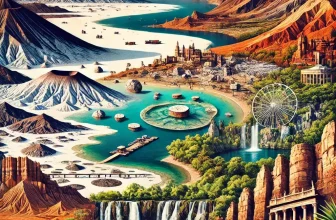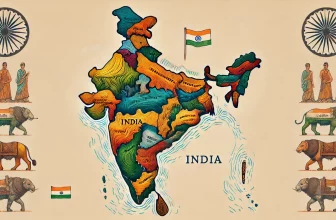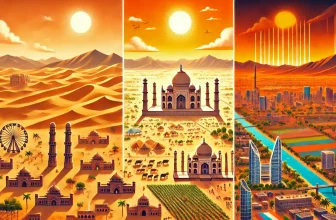Asia covers about 44.58 million square kilometers, making it the largest continent on Earth. That equals nearly 30% of the world’s total land area. Within this massive expanse lie almost 50 countries, each with its own geography, climate, and resources. Land size directly shapes a country’s access to resources, population distribution, and geopolitical influence. It is home to around 4.8 billion people, about 60% of the global population. From the Arctic in the north to the equator in the south, and from deserts to tropical rainforests, Asia’s geography is unmatched in diversity.
For countries, land area is not just a number. It determines climate zones, natural resources, agricultural capacity, and even geopolitical strength. Larger countries often control longer coastlines, richer mineral reserves, and broader cultural landscapes.
What “Largest” Means in This Context
In this list, “largest” is measured by land area in square kilometers. This does not include economic power or population size, though these factors often intersect with geography.
- Unit of measurement: square kilometers (km²).
- Source basis: UN geoscheme, CIA World Factbook, World Bank data.
- Special cases: Transcontinental countries like Russia and Turkey are counted only for their Asian portion. Indonesia and Malaysia are considered only for their Asian parts.
This ensures that comparisons remain consistent and focused on Asia as a continent.
The 23 Largest Countries in Asia
Asia’s largest countries vary greatly in geography, climate, and population density. Below is the ranking with explanations for each.
1. Russia (Asian part) – 13,000,000 km²
Nearly three-quarters of Russia lies in Asia, though most of its population lives in the European part. Siberia dominates Asian Russia with permafrost, taiga forests, and Arctic tundra. It accounts for almost a third of Asia’s total landmass.
2. China – 9,596,961 km²
China stretches from the Gobi Desert in the north to the tropical south, and from the Tibetan Plateau to the Pacific coast. Its vast size supports multiple climate zones, making it both agriculturally rich and resource diverse.
3. India – 3,287,263 km²
India is the third largest country in Asia and seventh globally. Its geography includes the Himalayan mountain range, the Indo-Gangetic plains, the Thar Desert, and the Deccan Plateau. With over 7,500 km of coastline, it is a maritime as well as continental power. Despite being smaller than Russia or China, India’s population density makes its land far more intensively used.
4. Kazakhstan – 2,724,900 km²
Kazakhstan is a landlocked giant, with vast steppe grasslands and deserts. Though sparsely populated, its size gives it abundant oil, gas, and mineral resources.
5. Saudi Arabia – 2,149,690 km²
The largest country in the Middle East, dominated by the Rub’ al Khali desert, Saudi Arabia controls both Red Sea and Persian Gulf coastlines. Its land size underpins its role in global energy supply.
6. Iran – 1,648,195 km²
Iran’s mountainous terrain includes the Zagros and Alborz ranges, alongside desert basins. Its size positions it as a strategic bridge between South Asia, Central Asia, and the Middle East.
7. Mongolia – 1,564,116 km²
Known for the Gobi Desert and sweeping grasslands, Mongolia is one of the least densely populated countries in the world. Its land is vast but lightly inhabited.
8. Indonesia (Asian part only) – 1,502,000 km²
Indonesia spans thousands of islands. The Asian portion (Sumatra, Java, Borneo) covers over 1.5 million km², rich in rainforests, coal, and palm oil plantations.
9. Pakistan – 881,913 km²
Pakistan combines Himalayan mountains in the north, fertile plains in Punjab, and arid deserts in Sindh and Baluchistan. Its geography makes it central to South Asian trade and agriculture.
10. Turkey (Asian part) – 756,000 km²
The Anatolian Peninsula forms Turkey’s Asian share. It is geographically diverse, with mountains, fertile valleys, and access to both Black Sea and Mediterranean.
11. Myanmar – 676,578 km²
Myanmar’s land includes mountainous north, fertile river basins, and a long coastline on the Bay of Bengal and Andaman Sea.
12. Afghanistan – 652,230 km²
A rugged, landlocked country with mountain-dominated terrain. Its strategic location has shaped its history as a crossroads of empires.
13. Yemen – 527,968 km²
Located at the southern tip of the Arabian Peninsula, Yemen’s land is mostly arid but has a crucial coastline along the Red Sea and Gulf of Aden.
14. Thailand – 513,120 km²
Thailand’s geography includes the northern highlands, the fertile Chao Phraya River basin, and the long southern peninsula.
15. Turkmenistan – 488,100 km²
Home to the Karakum Desert, Turkmenistan is rich in natural gas. Its land is largely arid but resource-heavy.
16. Uzbekistan – 447,400 km²
Mostly desert and steppe, Uzbekistan also borders the shrinking Aral Sea.
17. Iraq – 437,072 km²
Iraq’s fertile Tigris-Euphrates basin makes it historically significant as Mesopotamia. Despite conflict, its geography remains central to Middle Eastern agriculture.
18. Japan – 377,975 km²
Though not very large by continental standards, Japan’s archipelago is mountainous and volcanic, influencing its settlement patterns.
19. Vietnam – 331,212 km²
Vietnam’s long, narrow shape stretches along the South China Sea, with fertile deltas in the north (Red River) and south (Mekong).
20. Malaysia (Asian part only) – 330,000 km²
Peninsular Malaysia is tropical, with dense forests and extensive coastlines.
21. Oman – 309,500 km²
Oman’s land is desert-dominated but strategically located along the Arabian Sea, controlling access to the Strait of Hormuz.
22. Philippines – 300,000 km²
An island nation with over 7,000 islands, volcanic mountains, and typhoon-prone climate.
23. Laos – 236,800 km²
A landlocked country dominated by mountains and the Mekong River basin.
India’s Place in Asia and the World
India stands third in Asia, after Russia and China, and seventh globally. What sets India apart is not just land area but how that land is used:
- India’s population density is much higher than most countries on this list.
- Its fertile plains, long coastline, and varied climate zones support one of the world’s most diverse agricultural systems.
- Its location at the center of South Asia gives it strategic influence in trade, defense, and connectivity.
And India’s geography is marked by extremes:
- North: Himalayas, the world’s highest mountains.
- West: The Thar Desert.
- Center: Deccan Plateau.
- East and South: Fertile river plains and over 7,500 km of coastline.
This diversity gives India both agricultural richness and strategic maritime access, strengthening its regional role.
Comparing Asia’s Giants
- Russia’s Asian landmass alone is more than four times India’s size.
- China is nearly three times larger than India by area, though both are similar in population scale.
- Kazakhstan and Saudi Arabia, though much less populated, rank above many Asian peers due to their sheer land spread.
A bar chart or map showing the top 10 countries makes these differences clearer for readers.
Quick Recap: 23 Largest Asian Countries by Land Area
| Rank | Country | Land Area (km²) | Share of Asia (%) | Global Rank |
|---|---|---|---|---|
| 1 | Russia (Asian part) | 13,000,000 | 29.2% | 1 (overall Russia) |
| 2 | China | 9,596,961 | 21.5% | 4 |
| 3 | India | 3,287,263 | 7.4% | 7 |
| 4 | Kazakhstan | 2,724,900 | 6.1% | 9 |
| 5 | Saudi Arabia | 2,149,690 | 4.8% | 12 |
| 6 | Iran | 1,648,195 | 3.7% | 17 |
| 7 | Mongolia | 1,564,116 | 3.5% | 18 |
| 8 | Indonesia (Asian part only) | 1,502,000 | 3.4% | 14 (overall Indonesia) |
| 9 | Pakistan | 881,913 | 2.0% | 33 |
| 10 | Turkey (Asian part) | 756,000 | 1.7% | 37 (overall Turkey) |
| 11 | Myanmar | 676,578 | 1.5% | 40 |
| 12 | Afghanistan | 652,230 | 1.5% | 41 |
| 13 | Yemen | 527,968 | 1.2% | 49 |
| 14 | Thailand | 513,120 | 1.2% | 51 |
| 15 | Turkmenistan | 488,100 | 1.1% | 52 |
| 16 | Uzbekistan | 447,400 | 1.0% | 56 |
| 17 | Iraq | 437,072 | 1.0% | 57 |
| 18 | Japan | 377,975 | 0.8% | 62 |
| 19 | Vietnam | 331,212 | 0.7% | 65 |
| 20 | Malaysia (Asian part only) | 330,000 | 0.7% | 66 (overall Malaysia) |
| 21 | Oman | 309,500 | 0.7% | 70 |
| 22 | Philippines | 300,000 | 0.7% | 72 |
| 23 | Laos | 236,800 | 0.5% | 81 |
Summary – India’s position in Asia’s Largest Countries by Area
The 23 largest countries in Asia highlight the continent’s extremes: Siberia’s frozen landscapes, Arabia’s deserts, India’s crowded plains, and Indonesia’s tropical islands.
India’s position, large enough to be 3rd in Asia but far denser than its peers, makes it unique. Russia and Kazakhstan may have larger territories, but vast portions are sparsely populated. In contrast, nearly every corner of India is actively lived in, farmed, or industrialized.
Sources:
- https://www.india.gov.in/india-glance/profile
- https://www.cia.gov/the-world-factbook/field/area/country-comparison/
- https://data.worldbank.org/indicator/AG.LND.TOTL.K2





